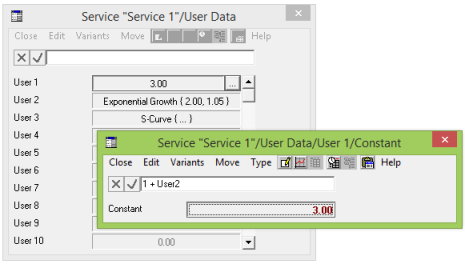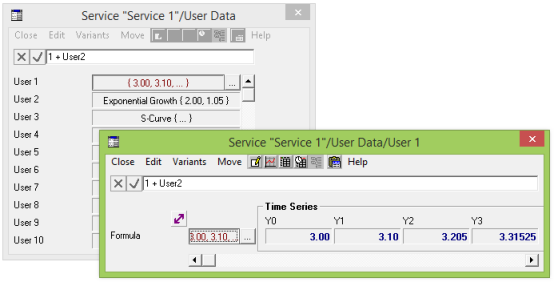A time-series input in STEM can be defined as one of a number of alternative parameterisations, such as Exponential Growth or S-Curve. The simplest Constant type is logically defined with a single, ‘inner’ parameter. However, in previous versions of STEM, there was scope for ambiguity between this inner, scalar parameter, and the value of the time-series overall (‘button level’).
There are four subtle changes in STEM 7.5 which are intended to avoid such confusion:
-
If a formula is entered on the button as a simple reference to another time series, then the inner parameters are now always overwritten unconditionally, to avoid a remaining Constant parameter entirely overriding the formula.
-
A formula entered for the Constant parameter will be handled as if it were entered at the button level, to avoid references to other inputs being converted to a scalar.
For example, if you entered a formula (1 + User 2) for a Constant parameter in STEM 7.4, then STEM would select the first value from the User 2 time-series and use it to produce a new scalar constant, as shown in Figure 1 below.

Figure 1: Entering a formula for a Constant in STEM 7.4
In contrast, when you enter the same formula for the Constant in STEM 7.5, it is now treated as though you entered the formula on the button, such that you get a series of values, each equivalent to 1 + User 2, as determined by the formula and shown in Figure 2.

Figure 2: Entering a formula for a Constant in STEM 7.5
In addition to and for consistency with (1), if you edit a formula for a time series and delete all the text then the whole time-series will be unset, as per the behaviour for a scalar input.
-
Any attempt (either menu- or formula-driven) to point a scenario parameter at the Constant field will be redirected to the button as a whole (and the whole Variants menu will act as if the button were selected when the focus is on a Constant field).
-
A value entered for the Constant can only be stored ‘inside’, but:
-
the button reflects any setness for the Constant so it is clear when it overrides any linked defaults, and
- the value is shown in the formula bar at the button level for consistency and to make it easier to edit an existing constant at the button level.
Note: we are also considering unsetting the whole time-series if you select Unset from the Type menu, but this remains to be determined.
In summary, STEM 7.5 aims to avoid any confusion or conflict resulting from the separate use of the Constant ‘inner’ parameter and the time-series field as a whole.